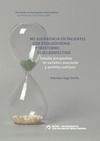Please use this identifier to cite or link to this item:
https://accedacris.ulpgc.es/jspui/handle/10553/106585
| Title: | No adherencia en pacientes con esquizofrenia y trastorno esquizoafectivo. Estudio prospectivo de variables asociadas y posibles subtipos | Authors: | Vega Dávila, Dulcinea Cruz | Director: | Acosta Artiles, Francisco Javier Saavedra Santana, Pedro |
UNESCO Clasification: | 32 Ciencias médicas 6105 Evaluación y diagnóstico en psicología 3211 Psiquiatría |
Keywords: | Adherencia No adherencia Estudio prospectivo Hospitalización Esquizofrenia, et al |
Issue Date: | 2021 | Abstract: | Introducción. La tasa de no adherencia al tratamiento en la esquizofrenia se sitúa entre el 40-50 %. La escasa consistencia en las variables identificadas asociadas a no adherencia puede deberse,entre otros factores, a una heterogeneidad real entre los pacientes no adherentes. Objetivos. 1. Evaluar la prevalencia de la no adherencia en pacientes con esquizofrenia y trastorno es-quizoafectivo tras el alta hospitalaria, y las variables asociadas a esta. 2. Evaluar los posibles subtipos de no adherencia según intencionalidad, y las variables asociadas a estos. Metodología. Se incluyeron 110 pacientes ingresados consecutivamente con diagnóstico de esquizofreniay trastorno esquizoafectivo. Fueron evaluados durante el ingreso y a los seis meses del altahospitalaria. Se incluyeron variables socio demográficas, clínicas, psicopatológicas, y relacio-nadas con el tratamiento. La adherencia se definió como la concurrencia de adherencia altratamiento antipsicótico y al seguimiento ambulatorio. Se asignó el subtipo de no adhe-rencia según los motivos de no adherencia. Resultados. Se halló no adherencia en el 58,2 % de los pacientes. El nivel socioeconómico bajo (OR = 3,68;IC95 % = 1,42 – 9,52), el consumo de cannabis (OR = 2,79; IC95 % = 1,07 – 7,28), la no adherenciacomo motivo de recaída e ingreso (OR = 5,46; IC95 % = 2,00 – 14,90) y la gravedad de los sín-tomas (OR = 2,00; IC95 % = 1,02 – 3,94) se asociaron de manera independiente a la no adhe-rencia. Se identificaron dos subtipos de no adherencia. El nivel educativo bajo (OR = 26,1; IC95% = 2,819 – 241), el peor conocimiento del tratamiento a los seis meses (OR= 0,904; IC95 %= 0,853 – 0,957) y el uso de tratamiento no psiquiátrico a los seis meses (OR = 15,8; IC95 % =1,790 – 139) se asociaron de manera independiente al subtipo de no adherencia no intencional. Conclusiones. Un alto porcentaje de los pacientes con esquizofrenia y trastorno esquizoafectivo no mues-tran adherencia tras el alta hospitalaria. El perfil identificado puede facilitar su prevención.Parecen existir subtipos de no adherencia según la intencionalidad, lo que sugiere la nece-sidad de un abordaje diferenciado, tanto en investigación como en la práctica clínica. Background Reported non-adherence rates in schizophrenia range between 40% and 50%. The scarcityof consistently identified variables associated with nonadherence could be due, at least inpart, to real heterogeneity among nonadherent patients. Objectives 1. To evaluate the prevalence of nonadherence among hospitalized patients with schizoph-renia or schizoaffective disorder during the post-discharge period and variables associated.2. To evaluate the possible subtypes of nonadherence according to intentionality and varia-bles associated. Methods We assessed 110 consecutively admitted patients diagnosed with schizophrenia or schizoaf-fective disorder. Assessments were performed during hospita lization and at six-months fo-llow-up. Evaluation included sociodemographic, clinical, psychopathologic and treatment-related variables. Adherence was defined as the concurrence of adherence to antipsychotictreatment and adherence to outpatient follow-up, during the six-month period. Subtype ofnonadherence was established according reasons for nonadherence. Results Nonadherence was detected in 58.2% of patients. Low socio-economic level (OR = 3.68; 95%CI= 1,42–9,52), current cannabis use or abuse (OR = 2.79; 95%CI = 1,07–7,28), nonadherence asa reason for relapse and admission (OR = 5.46; 95%CI = 2,00–14,90), and greater severity ofsymptoms at six months follow-up (OR = 2.00; 95%CI = 1,02–3,94) remained independentlyassociated with nonadherence. Two distinguishable subtypes of nonadheren ce were iden-tified. Low educational level (OR = 26.1; 95%CI = 2.819–241), worse treatment knowledge atsix months (OR= 0.904; 95%CI = 0.853–0.957) and nonpsychiatric treatment at six months(OR = 15.8; 95%CI = 1.790–139) were independently associated to unintentional nonadherence subtype. Conclusions A large percentage of patients with schizophrenia or schizoaffective disorder did not adhereto their treatment in the post-discharge follow-up period. The profile identified may enablebetter prevention of this problem. Differentiated subtypes of nonadherence according tointentionality seem to exist, which suggest the need for differentiated approach, both in re-search and in clinical practice. |
Description: | Programa de Doctorado en Investigación en Biomedicina por la Universidad de Las Palmas de Gran Canaria | Department: | Departamento de Ciencias Médicas y Quirúrgicas | Faculty: | Facultad de Ciencias de La Salud | URI: | https://accedacris.ulpgc.es/handle/10553/106585 |
| Appears in Collections: | Tesis doctoral |
Page view(s)
955
checked on Nov 1, 2024
Download(s)
1,911
checked on Nov 1, 2024
Google ScholarTM
Check
Share
Export metadata
Items in accedaCRIS are protected by copyright, with all rights reserved, unless otherwise indicated.
